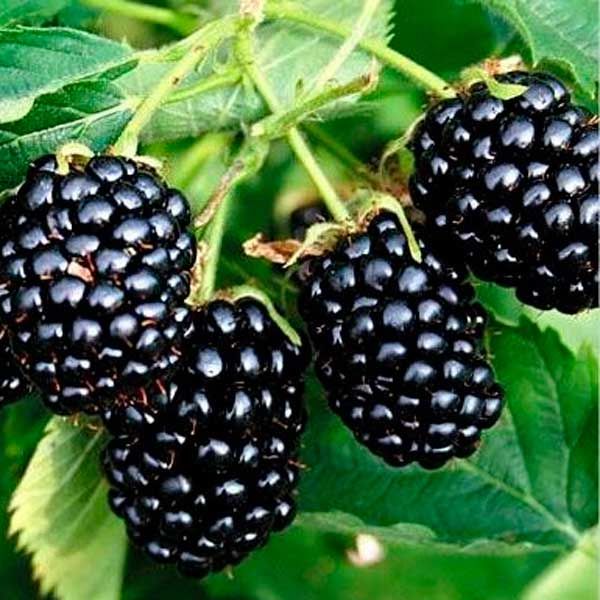Very often in the garden plots you can find blackberries. The Natchez variety of blackberries is distinguished by the fact that ripe and tasty berries can be pampered at the end of June.
In this article we will talk about the description and characteristics of this type of blackberry.
Table of contents
Description of Blackberry Natchez
Natchez is a creeping shrub with no thorns. Immediately after planting, the branches begin to grow upwards, but after the appearance of the first harvest, they tend to the ground.This feature is due to the severity of the fruit or strong winds. The length of the shoots in the middle is 5 meters.
Flowering occurs in late May. Blackberry flowers are white and large, with 5-6 petals. The leaves of this variety are light green in color with a pubescent surface; a slight serration is seen at the edges.
In the presence of favorable climatic conditions, the berries ripen at the end of June, the fruiting period can last up to 1.5 months. At full maturity, the blackberry keeps well on the branches and does not fall for a long time. The variety is suitable for growing only in the southern regions, because the bush has low resistance to frost.
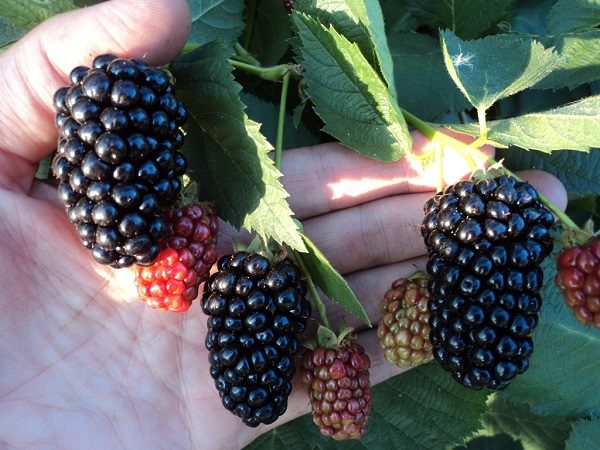
Characteristic berries
The very first crop of blackberry Natchez produces fruits 3.5 centimeters long and weighing 14 grams, then these dimensions increase to 5 centimeters and 22 grams. The shape of the berries is oblong-cylindrical. The color is dark blue, almost black with a pronounced brilliance. The taste of blackberry is excellent, sweet and slightly sour, the seeds are small.
Natchez varieties of blackberry are collected in brushes of 10-30 pieces, when fully ripe, they come off well, and the sepal dries.
Breeding history and region of growth
The variety was bred by the American breeder John Clark at the Scientific University of Arkansas in 2007. Blackberry Natchez is considered one of the youngest types of this culture.
The advantages and disadvantages of the variety
- There are no thorns on the bush, which makes caring for them easier and more convenient.
- Berries ripen in late June. In the same period, the fruits of other varieties are still green.
- Also, the fruits are very large, beautiful and tasty. They are great for both private use and for commercial use.
- Good transportability and long shelf life of the blackberry characterizes the variety from the positive side.
- The fruiting period can last up to 1.5 months, which allows you to feast on fresh berries from the beginning to the end of summer.
- Another distinguishing feature is good resistance to diseases and pests.
- The shrub has poor frost resistance and can be damaged even with weak frosts.
- The branches are distinguished by their fragility and weakness, so they need additional support.
- The variety is very demanding of sunlight. With insufficient light and heat, the blackberry cannot fully mature.
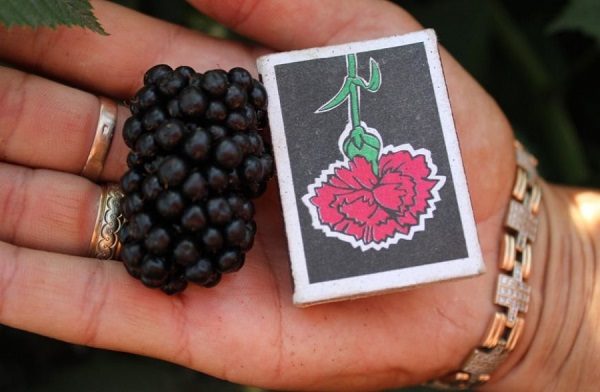
Planting seedlings
Blackberries varieties Natchez decided to plant in the spring. Due to low frost resistance, the shrub may not survive the winter after an autumn planting. The most favorable time will be April, while the buds did not have time to blossom. It is worth remembering that the plant planted in the spring requires additional shelter for the winter.
When choosing a place for a blackberry, you should consider its preferences:
- The soil should be fertile, loamy or sandy, sand is required.
- It is best to use the land with a low or neutral level of oxidation.
- Highly dispersed groundwater can erode the root system, which can cause rot. Therefore it is very important to provide a safe site.
- The site for blackberries should be well lit and ventilated, but at the same time, the shrub protects from gusty winds and the scorching rays of the sun.
When planting a blackberry at the dacha, you must adhere to the following instructions:
- It is necessary to dig up and remove all weeds beforehand.
- The distance between the pits is 1.5 - 2.5 meters, with the depth and width of the hole equal to about 50 centimeters.
- At 2/3 of the depth in the landing pit make a mixture consisting of:
- Topsoil;
- 2 buckets of humus or compost;
- 100 grams of superphosphate;
- 60 grams of potassium.
- Then a seedling is installed inside the hole, the roots must be gently spread.
- When powdering a seedling with earth, it is gently shaken to avoid the formation of air gaps between the roots.
- A well is formed around the planted shrub, about 50 centimeters deep, after which the blackberry is poured over it with 2 buckets of water.
- At the last stage, the trunk circle must be carefully mulched.
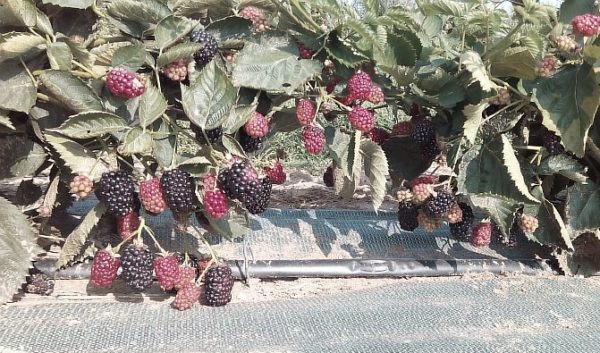
Growing conditions
To shrub gave a bountiful harvest, you need to properly care for him, observing all the prescribed rules.
Variety Natchez tolerates the absence of moisture, but do not abuse this opportunity. The appearance of beautiful and tasty fruits completely depends on the abundance and quality of watering. Once a week, blackberries are poured over with 4-5 buckets of water.
Blackberries Natchez is usually grown with a support or on a trellis, 1.7 -1.8 meters high. In this case, the branches will be easier to hold the crop, and they will not break.
Natchez forms new shoots for quite a long time, so you can trim a shrub 1 time in 2 years, adhering to the following rules:
- It is necessary to remove new shoots that will subsequently interfere with fruiting.
- In order that the blackberry would give a good harvest, 6-8 main stems will be enough for the shrub, the rest can be safely removed.
- Lateral processes are shortened by 30 centimeters.
- Also mandatory will be sanitary pruning, during which all dry, damaged and excessively thickening crown branches are removed.
It is necessary to feed the blackberry several times per season, using various fertilizers:
- In the spring, before bud break, a tree trunk is dug over with the addition of 8 kilograms of compost (humus) or 50 grams of ammonium nitrate.
- Before flowering the shrub is watered with the following mixture:
- 2 kilograms of fresh mullein diluted in 10 liters of water;
- Another option would be 1 kilogram of bird droppings mixed with 10 liters of water.
- After fructification, the earth is loosened with the addition of 500 grams of wood ash and 100 grams of superphosphate.
Since the Natchez variety does not tolerate frosts, the shrub needs to be prepared for the winter period. The branches are laid on the ground and covered with insulation, which can serve as:
- Corn leaves;
- Sawdust and humus;
- Hay, straw, vegetable tops.
Then the resulting structure is covered with a dense plastic wrap. For the best preparation of the shrub for the cold, experienced gardeners remove 2-year-old shoots and all damaged branches.
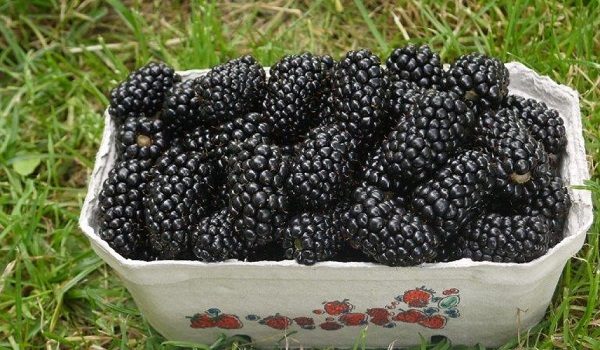
Diseases and pests
Blackberry Natchez has excellent resistance to many diseases and pests. But in order to completely protect yourself from trouble, it is recommended to adhere to the following preventive measures:
- To avoid rust, shrubs are treated with 1% Brodsky liquid., carefully weed the tree trunk circle and remove all fallen leaves.
- Anthracnose and septoria can significantly damage the plant, against these diseases also use 1% Brodsky liquid.
To ward off the shrub medvedka, crunches, aphids, larvae and caterpillars before blooming leaves and before the onset of fruiting, spray it with the following solution:
- 200 grams of tobacco dust is mixed with 10 liters of water and infused for 3 days;
- Then the mixture is filtered and 10 liters of water are added again;
- Before spraying, add 5 grams of laundry soap to 1 liter of the solution.
To combat the tick and sawfly in the fall, the trunk circle mulch with peat or humus,layer of mulch should be more than 8 centimeters. After flowering, the blackberry is treated with 100 grams of carbolic soap mixed with 15 liters of water.
Blackberry variety Natchez is one of the best selection of discoveries. She has a perfect taste and appearance. A significant drawback will be the impossibility of its cultivation in areas that are farther than the southern region.
